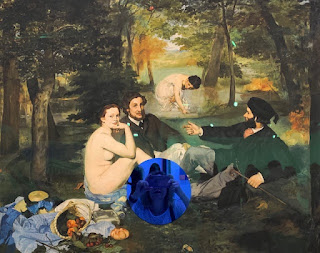 |
Maurizio Cattelan's "Comedian"
and my own banana for reference,
which I ate after taking this shot
|
Cattelan is an internationally acclaimed artist known for his satiric sculptures. You may have heard of his "America," a working toilet made of 18K gold that was installed at the Guggenheim Museum. Yes, people waited on line to use it, an experience that I was able to resist. I missed my opportunity. "America" was stolen when on loan for an exhibit at Blenheim Palace outside London. My favorite fact about the toilet is that the Guggenheim offered it to the Trump White House in lieu of a requested loan of a Van Gogh painting. The White House declined. Click here read more about the controversial Cattelan and see more of his work. And click here to read about the New York performance artist WHO ATE THE BANANA!!!! A new banana was put up in its place. No big deal, apparently. It was easy enough to replace.
 |
With "quadro quadro distortion" by Renata
Lucas and "Lava" by Federico Herrero
|
Lucas is known for works that, according to Artes Mundi, "offer an alternative spatial imagination." I'm not sure I get that from "quadro quadro distortion," but a larger version of this picture does yield a Picasso-esque version of my face reminiscent of being in a carnival funhouse. To read more about Lucas, click here.
Unlike much of the work at Art Basel, I could easily imagine Herrero's vibrant painting on the walls of my home. That would likely please the populist artist who has used the walls of parking garages and buses as his canvases. His first works hung from trees in his native Costa Rica, an homage to the environment that inspires his abstract landscapes. For more on Herrero, click here.
 |
I considered taking up residence in
Oscar Tuazon's "Quonset Hut"
|
Tuazon is interested in the mobility of his work and the ability of his creations to be different things at different times. With "Quonset Hut," he's created a space that is temporary but could be made permanent. It's open to the air and light but could be covered and a wood stove installed if required. And it can easily serve multiple functions -- as interactive art, as a stage, as a place to rest one's weary head (and feet) after a day at Art Basel, so long as you aren't fussy about sitting on the floor. To read more about Tuazon, click here.
 |
| With Michelangelo Pistoletto's "Maria in Color" |
Pistoletto is one of the protagonists of the Italian Arte Povera--or "poor art"--movement. The objective behind Arte Povera was to blur the lines between art and the real world by using non-traditional materials. Pistoletto's mirror paintings fit squarely within the philosophy of the movement.
When Pistoletto first began creating these works in the '60s, he would paint or collage the image directly onto the highly polished stainless steel surface. He later turned to silkscreening. I came across four of his works at Art Basel and was drawn to them each time. Not only did I enjoy interacting with them, but it was fun to see other art lovers do so as well. To see more examples of his mirror paintings, click here. To read a much more eloquent description of the intention behind Pistoletto's work, click here. And to go down the rabbit hole of Art Povera and the artists who participated in this social movement, click here.
 |
Gazing into Jeff Koons' "Gazing Ball
(Manet Luncheon on the Grass)"
|
Next up: My Favorite 3D art at Art Basel.



No comments:
Post a Comment